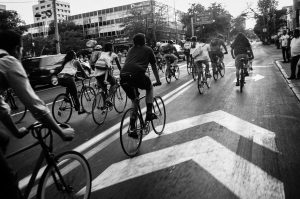“Urban roads aren’t meant for bicycles,” was the headline of a 2015 Boston Globe editorial by long-time columnist and WBUR commentator Jeff Jacoby, following the 13th tragic bicycle crash death in the city in five years.
“That number is sure to rise if Boston keeps encouraging people to ride bicycles where bicycles don’t belong,” Jacoby wrote, adding that if people want to ride bicycles, “Massachusetts Avenue during business hours shouldn’t be one of them.”
As longtime Boston bicycle attorneys and cycling rights advocates, the fact was then (as now) MGL Ch. 85 s. 11B legally gives bicyclists the same right to the road as motorists, with few exceptions. But we’ll give the writer this much: Boston roads weren’t meant for bicyclists, at least in the 20th Century (though cyclists were the driving force behind the first paved roads in the U.S., before cares become commercially available 110 years ago). American traffic engineers throughout the 1900s, however, made cars the priority, building wider lanes that encouraged higher speeds.
This, combined with the fact none of us alive today remember life before automobiles likely fuels drivers’ sense of roadway space entitlement. Regardless of who was here “first,” the fact that something has been done a certain way for a century doesn’t mean it should stay that way – particularly if it is proving inefficient and especially if it isn’t safe for others sharing that space lawfully.
Leaders with both The City of Boston and the Massachusetts Department of Transportation don’t appear to be heeding critics like these, instead recently pledging further commitment to the cause of multi-modal traffic infrastructure that offers more options for safe access. Continue reading
 Bike Accident Lawyers Blog
Bike Accident Lawyers Blog


 It was founded to remember those injured and killed in traffic crashes (including Boston bicycle crashes) – and demand our elected officials take action. In Boston this year, it will include a memorial bike ride, a memorial walk, a vigil and rally at the steps of the state house. This will be followed by a press conference, wherein organizers will release new information about the lack of accountability in a recent fatal Boston bicycle crash.
It was founded to remember those injured and killed in traffic crashes (including Boston bicycle crashes) – and demand our elected officials take action. In Boston this year, it will include a memorial bike ride, a memorial walk, a vigil and rally at the steps of the state house. This will be followed by a press conference, wherein organizers will release new information about the lack of accountability in a recent fatal Boston bicycle crash.